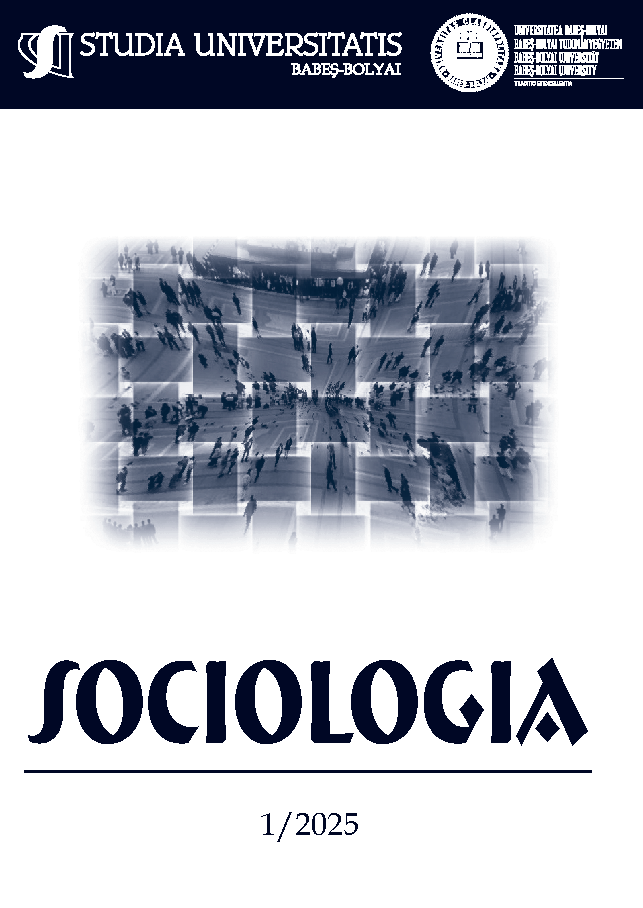CYCLING IN CLUJ-NAPOCA: AN ACTOR-NETWORK ANALYSIS OF URBAN MOBILITY AND SPATIAL INEQUALITY
DOI:
https://doi.org/10.2478/subbs-2025-0004Keywords:
Actor-Network Theory, cycling infrastructure, green-blue corridors, spatial inequality, alternative mobilityAbstract
This study explores the dynamics of alternative urban mobility, with a focus on cycling, in the context of Cluj-Napoca. Our analysis, anchored in actor-network theory (ANT) and critical sociological literature, examines bicycle infrastructure not only as a physical support but also as a materialization of power relations and processes of social (de)legitimization. Through semi-structured interviews with users and experts, we investigate how fragmentation, spatial inequality, and compliance with existing car legislation influence the experiences of urban cyclists. We identify how certain interventions, such as green-blue corridors, can contribute to the reconfiguration of urban space and the promotion of more equitable and sustainable mobility. The article contributes to a nuanced understanding of the role of bicycle infrastructure as a terrain for negotiation between human and non-human agents, norms, daily practices, and authority, revealing the complexity of the dynamics between space, power, and identity in contemporary urban societies.
References
“What Is Level of Service (LOS) in Traffic?” (2024) ISARSOFT. June 1, 2024.
Ahuja, S. n.d. “Walk Score/Transit Score/Bike Score.” Cave. Tool., https://help.covetool.com/en/articles/3703323-walk-score-transit-score-bike-score, 31.08.2024
Arellana, Julian, Daniel Oviedo, Luis A. Guzman, and Vilma Alvarez (2021). Urban Transport Planning and Access Inequalities: A Tale of Two Colombian Cities. Research in Transportation Business & Management 40 (September): 100554. https://doi.org/10.1016/j.rtbm.2020.100554.
Banca Europeană pentru Reconstrucție și Dezvoltare. n.d. “Planul de Mobillitate Urbană Durabilă Pentru Polul de Creștere Timișoara.”
Bencherki, Nicolas (2017). “Actor–Network Theory.” In The International Encyclopedia of Organizational Communication, 1–13. Wiley. https://doi.org/10.1002/9781118955567.wbieoc002.
Bonham, Jennifer, and Cox Peter. (2010) “The Disruptive Traveller?: A Foucauldian Analysis of Cycleways.” Road & Transport Research 19 (2): 42–53.
Bourdieu, P. (1989) “Social Space and Symbolic Power.” Sociological Theory 7 (1): 14–25.
Civitta Strategy & Consulting S.A., and TTL Planning SRL (2022) “Planul de Mobilitate Urbană Durabilă Cluj-Napoca 2021-2030.” Cluj-Napoca.
Cordella, Antonio, and Maha Shaikh (2006) “From Epistemology to Ontology: Challenging the Constructed ‘Truth’ of ANT.”
Cox, P. (2020) “Theorising Infrastructure: A Politics of Spaces and Edges.” In The Politics of Cycling Infrastructure. Spaces and Inequality, edited by Peter Cox and Peter Koglin, 15–34. Bristol: Policy Press.
Cresswell, Tim. 2011. “Mobilities I: Catching Up.” Progress in Human Geography 35 (4): 550–58. https://doi.org/10.1177/0309132510383348.
Dolwick, Jim S. (2009) “‘The Social’ and Beyond: Introducing Actor-Network Theory.” Journal of Maritime Archaeology 4 (1): 21–49. https://doi.org/10.1007/s11457-009-9044-3.
Ebert, Anne-Katrin (2012) “When Cycling Gets Political.” The Journal of Transport History 33 (1): 115–37. https://doi.org/10.7227/TJTH.33.1.8.
Freund, Peter, and George Martin (1993) “The Social Inequities of Auto-Centred Transport.” In The Ecology of the Automobile, 45–60. Montreal/ New York, London: Black Rose Books.
Harvey, D. (1990) “Between Space and Time: Reflections on the Geographical Imagination.” Annals of the Association of American Geographers 80 (3): 418–34.
Held, Martin, Jorg Schindler, and Todd Litman. 2015. “Cycling and Active Mobility - Establishing a Third Pillar of Transport Policy.” In Cycling Futures. From Research into Practice, 1st Edition. London: Routledge.
Holifield, Ryan (2009) “Actor‐Network Theory as a Critical Approach to Environmental Justice: A Case against Synthesis with Urban Political Ecology.” Antipode 41 (4): 637–58. https://doi.org/10.1111/j.1467-8330.2009.00692.x.
Horton, Dave, Peter Cox, and Paul Rosen. (2007) “Introduction: Cycling and Society.” In Cycling and Society, 1st Edition. London: Routledge.
Koglin, T. (2020) “Spatial Dimensions of the Marginalisation of Cycling.” In The Politics of Cycling Infrastructure. Spaces and Inequality, edited by Peter Cox and Till Koglin, 55–72. Bristol: Policy Press.
Law, John, and Vicky Singleton. (2014) “ANT, Multiplicity and Policy.” Critical Policy Studies 8 (4): 379–96. https://doi.org/10.1080/19460171.2014.957056.
Law, John. 2009. “Actor-Network Theory and Material Simiotics.” The New Blackwell Companion to Social Theory, 141–58.
Lefebvre, Henri. 1991. “The Production of Space.” In The People, Place, and Space Reader, 1st Edition. London: Routledge.
Liotta, Charlotte, Yann Kervinio, Harold Levrel, and Léa Tardieu. (2020) “Planning for Environmental Justice - Reducing Well-Being Inequalities through Urban Greening.” Environmental Science & Policy 112 (October): 47–60. https://doi.org/10.1016/j.envsci.2020.03.017.
Mattioli, Giulio, Cameron Roberts, Julia K. Steinberger, and Andrew Brown (2020) “The Political Economy of Car Dependence: A Systems of Provision Approach.” Energy Research & Social Science 66 (August): 101486. https://doi.org/10.1016/j.erss.2020.101486.
Mol, Annemarie (1999) “Ontological Politics. A Word and Some Questions.” The Sociological Review 47 (1_suppl): 74–89. https://doi.org/10.1111/j.1467-954X.1999.tb03483.x.
Mom, Gijs. (2015) “The Crisis of Transport History: A Critique, and a Vista.” Mobility in History 6 (1). https://doi.org/10.3167/mih.2015.060102.
Oldenziel, R., and A. Albert de la Bruheze (2011) “Contested Spaces. Bicycle Lanes in Urban Europe, 1990-1995.” Transfers, 29–49.
Sarrica, Mauro, Eleonora Alecci, Paola Passafaro, Alessandra Rimano, and Bruno Maria Mazzara (2019) “The Social Representations of Cycling Practices: An Analysis of Symbolic, Emotional, Material and Bodily Components, and Their Implication for Policies.” Transportation Research Part F: Traffic Psychology and Behaviour 64 (July): 119–32. https://doi.org/10.1016/j.trf.2019.04.019.
Sheller, Mimi (2004) “Automotive Emotions.” Theory, Culture & Society 21 (4–5): 221–42. https://doi.org/10.1177/0263276404046068.
Sheller, Mimi, and John Urry (2000) “The City and the Car.” International Journal of Urban and Regional Research 24 (4): 737–57. https://doi.org/10.1111/1468-2427.00276.
Soja, Edward. 2010. “Spatializing the Urban, Part I.” City 14 (6): 629–35.
doi:10.1080/13604813.2010.539371.
Spinney, Justin (2010) “Performing Resistance? Re-Reading Practices of Urban Cycling on London’s South Bank.” Environment and Planning A: Economy and Space 42 (12): 2914–37. https://doi.org/10.1068/a43149.
Tempo Online. n.d. “Populatia Dupa Domiciliu.”
Tonkiss, F. (20050 “Spaces of Difference and Division.” In Space, the City and Social Theory, 30–58. Polity Press.
TTL PLANNING S.R.L., CIVITTA Strategy & Consulting S.A., and Bogazici Proje Muhendislik A.Ș. (2024) “Planul de Mobilitate Urbană Durabilă Regunea București-Ilfov 2.0.”
Urry, John (2004) “The ‘System’ of Automobility.” Theory, Culture & Society 21 (4–5): 25–39. https://doi.org/10.1177/0263276404046059.
Downloads
Published
How to Cite
Issue
Section
License
Copyright (c) 2025 Studia Universitatis Babeș-Bolyai Sociologia

This work is licensed under a Creative Commons Attribution-NonCommercial-NoDerivatives 4.0 International License.



